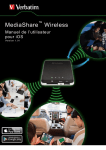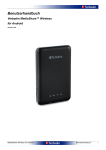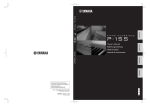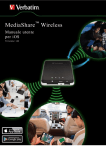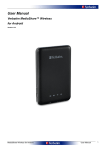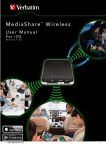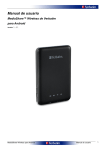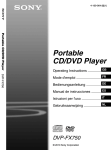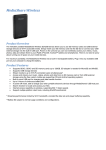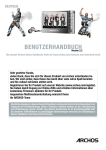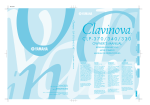Download USER MANUAL
Transcript
MediaShare ™ Benutzerhandbuch für iOS Version 1.01 Im App Store herunterladen Android-App auf Wireless Inhalt INHALT ........................................................................ 2 INFO ZU DIESEM HANDBUCH .................................. 3 PRODUKTÜBERSICHT .............................................. 3 PRODUKTEIGENSCHAFTEN ......................................... 3 BETRIEBSARTEN ........................................................ 3 TECHNISCHE DATEN................................................... 3 SYSTEMVORAUSSETZUNGEN ...................................... 3 PRODUKTABBILDUNG.................................................. 4 MEDIASHARE AUFLADEN ............................................ 4 SPEICHERGERÄTE ANSCHLIEßEN................................. 4 SD-Speicherkarte ................................................. 4 Externer USB-Speicher ........................................ 4 MOBILGERÄTE VERWENDEN .................................. 5 APP INSTALLIEREN ..................................................... 5 IPHONE/IPAD KABELLOS VERBINDEN............................ 5 APP STARTEN ............................................................ 5 GRUNDFUNKTIONEN ................................................... 6 Musik wiedergeben ............................................... 6 Videos abspielen .................................................. 7 Fotos anzeigen ..................................................... 8 Fotos teilen ........................................................... 8 Benutzerhandbuch für iOS Dokumente anzeigen ............................................9 VERWALTUNGSMODUS ................................................9 Kopieren und Löschen ..........................................9 MENÜ „SETTINGS“ (EINSTELLUNGEN) ........................10 MyMediaShare-Einstellungen .............................10 WLAN- und LAN-Einstellungen ........................... 11 Internet Settings (Internet-Einstellungen)............ 11 Schaltfläche „Clear Cache“ (Cache-Speicher löschen) ...................................12 MEDIASHARE-APP BEENDEN .....................................13 MEDIASHARE-APP DEINSTALLIEREN...........................13 HILFE .........................................................................13 EINGESCHRÄNKTE GARANTIEBEDINGUNGEN ...14 FCC-KONFORMITÄT ................................................14 CE-KONFORMITÄTSERKLÄRUNG .........................14 CANADA IC RSS-210:2010 .......................................14 WEEE-HINWEIS ........................................................14 RECHTE .....................................................................14 2 Betriebsarten Info zu diesem Handbuch In diesem Handbuch wird die Verwendung Ihres Verbatim MediaShare Wireless SD/USB-Geräts mit Ihrem iOS-Smartphone oder -Tablet beschrieben. Wenn Sie das MediaShare Wireless SD/USB-Gerät stattdessen mit einem Android-Smartphone oder -Tablet verwenden möchten, laden Sie bitte das Benutzerhandbuch für „MediaShare Wireless für Android“ herunter. Produktübersicht Das tragbare MediaShare Wireless SD/USB-Gerät von Verbatim ermöglicht es Ihnen, per WLAN auf Ihre SD-Speicherkarten und externen USB-Speichergeräte zuzugreifen. Stecken Sie hierzu einfach Ihre SD-Speicherkarte in den SD-Steckplatz oder Ihr externes USB-Speichergerät in den integrierten USB-Anschluss ein. Schalten Sie das Gerät ein, und schon können Sie kabellos auf Ihre Videos, Musikdateien, Fotos und Daten zugreifen und sie auf Ihr iPad®, iPhone®, Android™-Tablet oder -Smartphone streamen. So müssen Sie nie wieder befürchten, dass der Speicherplatz auf Ihrem Mobilgerät nicht ausreicht. Dank des integrierten Akkus können Sie Ihr MediaShare überall dabei haben. Den Akku können Sie ganz einfach an einen freien USB-Anschluss auf einem Computer anschließen, um den Akku aufzuladen. Produkteigenschaften Unterstützt SDXC-, SDHC- und SD-Speicherkarten bis zu 128 GB. SD-Adapter für MicroSD und MiniSD erforderlich. Unterstützt USB-Speichergeräte Medien können an bis zu fünf über WLAN verbundene Benutzer gleichzeitig gestreamt werden.* Zugriff und Streaming Ihrer Musik, Videos, Fotos und Daten von einer SD-Speicherkarte oder einem externen USB-Speichergerät über die kostenlose Mobil-App, die für iOS und Android verfügbar ist Integrierter Mikro-USB-Anschluss zum Aufladen und zur Datenübertragung Bis zu 9 Stunden durchgehender Akkubetrieb** Im ausgeschalteten Zustand können dank USB-Host-Anschluss am MediaShare weitere tragbare Elektronikgeräte aufgeladen werden. Suchfunktion für schnelles Auffinden und Aufrufen der Dateien Kabelloser Internetzugriff, unterstützt 802.11 b/g/n-Geschwindigkeiten Unterstützt Client-Tools für verschiedene Plattformen, u. a. iPad/iPhone/Android * Die Streaming-Leistung wird durch die WLAN-Bandbreite, die Datenrate der kodierten Dateien und die Pufferkapazität des Players begrenzt. ** Akkulaufzeit unter normalen Nutzungsbedingungen und Konfigurationen. Benutzerhandbuch für iOS Es gibt drei Hauptbetriebsarten. 1. Direkter USB-Anschluss. Verbinden Sie das Gerät über das im Lieferumfang enthaltene USB-Kabel mit dem USB-Anschluss Ihres Computers. Das Gerät wird automatisch auf Ihrem Desktop oder im „Arbeitsplatz“ angezeigt. In diesem Modus wird der MediaShare Wireless SD/USB-Akku aufgeladen, und Sie können Dateien zwischen Ihrem Computer und einer eingesteckten SD-Speicherkarte bzw. einem angeschlossenen USB-Laufwerk übertragen. 2. Kabellose Verbindung. Schalten Sie das Gerät ein, und suchen Sie mit Ihrem Mobilgerät nach verfügbaren WLAN-Verbindungen. Streamen Sie Musik oder Videos, die Sie zuvor auf einer SD-Karte oder einem Flash-Laufwerk gespeichert haben. 3. Kabelloser Modus mit Internet-Brücke. Verbinden Sie nach Aktivierung der Internet-Brückenfunktion MediaShare kabellos mit Ihrem vorhandenen WLAN-Router, um Zugriff auf das Internet zu erhalten. Technische Daten Abmessungen: 112 x 78 x 14 mm WLAN-Übertragung: Standard: 802.11 b/g/n Frequenz: 2,4 GHZ Geschwindigkeit: 72 Mbit/s bei 20 MHz / 150 Mbit/s bei 40 MHz WLAN-Sicherheit: WPA-PSK WPA2-PSK Mixed WPA/WPA2-PSK (Standard) Deaktiviert USB-2.0-Geräteanschluss: Für Datenübertragung und Aufladung Akku: 3000 mAh Kapazität Aufladung über USB-Mikro-B-Anschluss Ladedauer bis zu 7 Stunden Zulassungszertifizierungen: FCC (Klasse B), CE, IC RSS-210:2010 (Kanada), CEC-2012-BCS (Kalifornien, Effizienzvorgabe für Akkuladegeräte) Systemvoraussetzungen Internetverbindung (zum Herunterladen der Anwendung und des Benutzerhandbuchs und zur Verwendung mit der optionalen Internet-Brückenfunktion) MediaShare Wireless iOS-App (kostenloser Download im iTunes App Store) 3 Angeschlossenes Speichergerät erforderlich (mindestens 1 GB): SD-Karte (Klasse 4 und höher) oder USB-Flash-Laufwerk oder USB-Festplattenlaufwerk 200 MB verfügbarer Speicher auf der installierten SD-Karte oder dem installierten USB-Speichergerät, die für Systemfunktionen reserviert sind und daher nicht für Benutzerdaten zur Verfügung stehen. iPad, iPhone oder iPod Touch mit iOS-Version 4.0 oder höher. Produktabbildung 1 2 3 4 6. Reset-Taste Führen Sie einen schmalen Gegenstand (wie z. B. eine Büroklammer) ein, um die Taste zu drücken und das Gerät auf die Werkseinstellungen zurückzusetzen. Setzen Sie eine SD-Karte für den WLAN-Zugriff ein. Setzen Sie mithilfe eines geeigneten Adapters eine microSD-Karte ein. 7. SD-Kartensteckplatz 8. USB-Geräteanschluss 9. Netztaste Verwenden Sie das mitgelieferte USB-Kabel, um über USB 2.0 eine Verbindung mit einem Computer herzustellen und Daten zu übertragen. Verwenden Sie das mitgelieferte USB-Kabel, um eine Verbindung mit einem USB-Anschluss oder einem USB-Ladeadapter herzustellen und das Gerät aufzuladen. Schaltet das Gerät ein/aus. MediaShare aufladen 5 9 6 8 7 KOMPONENTE 1. AkkustandLED BESCHREIBUNG Leuchtet grün: Die Akkuladung liegt über 30 %. Leuchtet rot: Die Akkuladung liegt zwischen 10 % und 30 %. Blinkt schnell rot: Der Akku ist fast leer, und das Gerät wird in Kürze ausgeschaltet. Blinkt langsam grün (alle 2 Sekunden): Der Akku wird geladen. Blinkt langsam grün (alle 1,5 Sekunden): Das Gerät wird ausgeschaltet. LED aus: Das Gerät ist ausgeschaltet. 2. LED für Im WLAN-Datenträgermodus: Lesen/Schreiben Leuchtet blau: Speicherverbindung ist erfolgreich. Blinkt blau: Speicher wird gelesen oder geschrieben Im Kartenleser-Modus: Leuchtet blau: An USB 2.0 angeschlossen Blinkt blau: An USB 2.0 angeschlossen, Lese- oder Schreibvorgang. 3. WLAN-LED Blaue LED zeigt den WLAN-Verbindungsstatus. Blinken bedeutet, dass die Initiierung läuft. Leuchten bedeutet, dass die WLAN-Initiierung abgeschlossen ist. Die LED ist in folgenden Situationen AUS: Gerät ist eingeschaltet, aber das WLAN-Signal ist schwach. Gerät ist ausgeschaltet. Gerät befindet sich im Mobilmodus, aber WLAN ist ausgeschaltet. 4. Internet-LED Grün: Über die Brücke mit dem Internet verbunden. Aus: Nicht mit dem Internet verbunden. 5. USB-HostAnschluss Verbinden Sie MediaShare über das mitgelieferte Kabel mit einem stromgespeisten USB-Anschluss oder USB-Ladegerät, um den integrierten Akku aufzuladen. Das vollständige Aufladen des Akkus kann bis zu 7 Stunden dauern. Setzen Sie ein USB-Flash-Laufwerk oder eine USB-Festplatte für den WLAN-Zugriff ein. Im ausgeschalteten Zustand können Sie über den USB-Anschluss Ihr Smartphone oder Tablet aufladen. Benutzerhandbuch für iOS Speichergeräte anschließen MediaShare besitzt keinen internen Speicher. Sie müssen eine SD-Karte oder ein USB-Speichergerät einstecken, um MediaShare mit Ihrem Smartphone oder Tablet verwenden zu können. Sobald eine SD-Karte oder ein USB-Speichergerät an MediaShare angeschlossen ist, werden bis zu 200 MB von deren Speicherkapazität für temporäre Dateien und andere Systemfunktionen reserviert. Dieser Speicherplatz steht daher nicht für Benutzerdaten zur Verfügung. MediaShare unterstützt Speichergeräte mit FAT-, FAT32-, exFAT- (für SDXC) oder NTFS-Dateisystemen. Hinweis: Vergewissern Sie sich, dass MediaShare Wireless ausgeschaltet ist, bevor Sie die SD-Speicherkarte oder das USBGerät anschließen. Berühren Sie nicht die ungeschützten Steckverbinder auf Ihrer SD-Speicherkarte. SD-Speicherkarte Suchen Sie den SD-Speicherkarten-Steckplatz. Stecken Sie die Speicherkarte ein. Schieben Sie die Speicherkarte sanft nach hinten, bis sie einrastet. Externer USB-Speicher Suchen Sie den USB-Host-Anschluss auf dem Gerät. Stecken Sie ein USB-Laufwerk oder das Kabel einer tragbaren Festplatte in den USB-Anschluss ein. 4 Mobilgeräte verwenden App installieren Schalten Sie Ihr iOS-Gerät (iPhone, iPod Touch oder iPad) ein, und vergewissern Sie sich, dass eine Internetverbindung besteht. Tippen Sie auf das Symbol „App Store“ auf dem Startbildschirm, um den Play Store aufzurufen. Navigieren Sie zur kostenlosen App „MediaShare Wireless“, tippen Sie auf „Installieren“, und befolgen Sie die Installationsanweisungen auf dem Bildschirm. Nach Abschluss der Installation wird das „MediaShare Wireless“-App-Symbol auf dem Startbildschirm angezeigt. iPhone/iPad kabellos verbinden 1. 1. Schalten Sie MediaShare ein, und warten Sie auf die Initialisierung. Wenn die Initialisierung abgeschlossen ist, blinkt die WLAN-LED auf dem Gerät nicht mehr, sondern leuchtet blau. Wenn Sie das richtige Kennwort eingegeben haben, wird das Produkt in der Liste als „Verbunden“ angezeigt. App starten Tippen Sie auf Ihrem iOS-Mobilgerät auf das Symbol „MediaShare“, um die App zu starten. Die Startseite wird wie unten dargestellt angezeigt. Auf dem Bildschirm werden die Ordner/Dateien für das ausgewählte Gerät angezeigt (entweder MediaShare oder Smartphone/Tablet). Wenn Sie auf „MyMediaShare“ (Mein MediaShare) oder „My Device“ (Mein Gerät) tippen, können Sie zwischen diesen beiden Geräteansichten wechseln. 2. Tippen Sie auf Ihrem Mobilgerät auf das Symbol „Einstellungen“. 3. Tippen Sie auf „Wi-Fi“. Nun sollte der Netzwerkname „Verbatim-XXXX“ in der Netzwerkliste angezeigt werden. Tippen Sie zum Beispiel auf „Verbatim-866A“. „866A“ ist Teil der SSID und stellt die letzten 4 Zeichen der MAC-Adresse des Geräts dar. Rechts unten wird eine Menü-Schaltfläche mit drei Punkten angezeigt. Wenn Sie dieses Menü auswählen, werden die folgenden Optionen angezeigt: Wenn Sie „Verbatim-XXXX“ zum ersten Mal auswählen, werden Sie zur Eingabe des WLAN-Kennworts aufgefordert. Das Standardkennwort finden Sie auf dem Typenschild auf der Unterseite Ihres Geräts. Benutzerhandbuch für iOS Sprache Die Spracheinstellung wird standardmäßig von Ihrem iOS-Smartphone/Tablet zum Zeitpunkt der Installation übernommen. Wenn Sie zu einem späteren Zeitpunkt eine andere Sprache einstellen möchten, können Sie die Auswahl in diesem Menü vornehmen. Die folgenden Sprachen werden unterstützt: Englisch Französisch Italienisch Deutsch Spanisch Portugiesisch 5 Kroatisch Ungarisch Russisch Traditionelles Chinesisch Koreanisch Tschechisch Polnisch Serbisch Vereinfachtes Chinesisch Info Tippen Sie auf die Schaltfläche „About“ (Info), um die Firmware- und App-Versionsnummern anzuzeigen: Verwalten – Dateimanager zum Teilen, Kopieren, Löschen und Übertragen von Dateien. Suchfeld – Nach einem bestimmten Dateinamen bzw. einer bestimmten Dateierweiterung suchen. Menü mit drei Punkten – Menü-Liste für die folgenden Auswahloptionen anzeigen: About (Info), Language (Sprache), Copy (Kopieren), Now Playing (Aktuelle Wiedergabe), Remove USBDisk1 (USBDisk1 entfernen), Remove SDCard (SDCard entfernen). Kopieren Tippen Sie auf die Schaltfläche „Copy“ (Kopieren), um den Dateiübertragungsstatus anzuzeigen. Aktuelle Wiedergabe Wenn Musik im Hintergrund abgespielt wird, können Sie auf die Schaltfläche „Now Playing“ (Aktuelle Wiedergabe) tippen, um Informationen über den aktuellen Titel anzuzeigen. Remove SDCard (SDCard entfernen) Tippen Sie auf die Schaltfläche „Remove SDCard“ (SDCard entfernen), um einen gegenwärtig installierten SDCard-Datenträger sicher zu deinstallieren. Remove USBDisk1 (USBDisk1 entfernen) Tippen Sie auf die Schaltfläche „Remove USBDisk“ (USBDisk entfernen), um einen gegenwärtig installierten USBDisk-Datenträger sicher zu deinstallieren. Grundfunktionen Die Aktionsschaltflächen für „MyMediaShare“ (Mein MediaShare) werden oben im Bildschirm angezeigt und sind im Folgenden aufgeführt. Startbildschirm – Zurück zum Hauptbildschirm. Ansicht – Zwischen Listen- und Miniaturansicht wechseln. Einstellungen – MediaShare-Konfiguration Musik wiedergeben Tipp: Aus Organisations- und Bedienkomfortgründen empfiehlt es sich, einen oder mehrere Ordner zum Speichern Ihrer Musikdateien anzulegen. Musik- und Audiodateien können in „MyMediaShare“ (Mein MediaShare) und „My Device“ (Mein Gerät) abgespielt werden. Navigieren Sie einfach zu der Musik- oder Audiodatei, die Sie abspielen möchten. Tippen Sie auf die Datei, dann wird die Musik automatisch wiedergegeben. Hinweis: Informationen darüber, ob die Musik-/Audiodateien, die Sie abspielen möchten, auf Ihrem iOS-Mobilgerät wiedergegeben werden können, finden Sie im dazugehörigen Handbuch. Mit den folgenden Symbolen können Sie die Musikwiedergabe steuern: Wenn Sie auf dieses Symbol tippen, wird die Wiedergabe des aktuellen Titels erneut bei 0.00 gestartet. Bei doppeltem Tippen wird der vorherige Titel abgespielt. Wenn Sie auf dieses Symbol tippen, wird die nächste Musikdatei abgespielt. ändern. Zurück – Zurück zum vorherigen Bildschirm. Benutzerhandbuch für iOS Wenn Sie auf dieses Symbol tippen, wird die aktuell ausgewählte Musik- oder Audiodatei abgespielt. 6 Wenn Sie auf dieses Symbol tippen, wird die Musikwiedergabe angehalten/gestoppt. Es gibt fünf Wiedergabemodi: 1. Alle Titel wiederholen: Die Musik- oder Audiodateien werden nacheinander abgespielt, und die Wiedergabe wird erst beendet, wenn Sie auf die Schaltfläche „Pause“ tippen. (Standardmodus) 2. Aktuellen Titel abspielen: Der aktuell wiedergegebene Titel wird angehalten, und die Wiedergabe wird erneut bei 0.00 gestartet. 3. Aktuellen Titel wiederholen: Der aktuell wiedergegebene Titel wird fortlaufend abgespielt, und die Wiedergabe wird erst beendet, wenn Sie auf die Pause-Schaltfläche tippen. 4. Zufallswiedergabe aller Titel: Die Musikoder Audiodateien werden in zufälliger Reihenfolge abgespielt. 5. Aktuelle Liste abspielen: Die Musikoder Audiodateien werden nacheinander abgespielt. Tipp: Sie können auf die Musikfortschrittsanzeige tippen, sie halten und dann verschieben, um die Musik vor- bzw. zurückzuspulen. Tipp: Sie können die MusikPlayer-Oberfläche jederzeit beenden, die Musikwiedergabe wird dann im Hintergrund fortgesetzt. Videos abspielen Tipp: Aus Organisations- und Bedienkomfortgründen empfiehlt es sich, einen oder mehrere Ordner zum Speichern Ihrer Videodateien anzulegen. Film- und Videodateien können in „MyMediaShare“ (Mein MediaShare) und „My Device“ (Mein Gerät) abgespielt werden. Navigieren Sie einfach zu der Filmoder Videodatei, die Sie abspielen möchten. Tippen Sie auf die Datei, dann wird das Video automatisch abgespielt. Benutzerhandbuch für iOS Hinweis: Informationen darüber, ob die Film-/Videodateien, die Sie abspielen möchten, auf Ihrem iOSMobilgerät wiedergegeben werden können, finden Sie im dazugehörigen Handbuch. iOS-Geräte unterstützen normalerweise H.264- und MPEG-4Videodateien in den Dateiformaten .m4v, .mp4 und .mov. Die Wiedergabeleistung hängt von der Datenrate Ihrer kodierten Videodatei, der Leistungsfähigkeit Ihrer WLAN-Verbindung und der Anzahl von gleichzeitigen Benutzern ab. Wenn das Video abgespielt wird, die Wiedergabe jedoch kurzzeitig einfriert, dann können Sie versuchen, die Video-Wiedergabeleistung mit Hilfe der folgenden Schritte zu verbessern: 1) Kopieren Sie die Videodatei auf Ihr Smartphone/Tablet, und initiieren Sie die Wiedergabe von Ihrem Smartphone/Tablet. 2) Verringern Sie die Anzahl der gleichzeitig streamenden Benutzer. 3) Kodieren Sie die Videodatei erneut mit einer geringeren Datenrate. Video werden standardmäßig im Querformat wiedergegeben. Mit den folgenden Symbolen können Sie die Videowiedergabe steuern: Wenn Sie auf dieses Symbol tippen, wird das aktuell abgespielte Video angehalten, und der Videoplayer wird geschlossen. Wenn Sie auf dieses Symbol tippen, wird das Video an die Bildschirmgröße angepasst. Sie können auf die Videofortschrittsanzeige tippen, sie halten und dann verschieben, um das Video vor- bzw. zurückspulen. Sie können auf den Lautstärkeregler tippen, ihn halten und verschieben, um die Lautstärke zu erhöhen bzw. zu verringern. Sie können auf dieses Symbol tippen und es halten, um das Video während der Wiedergabe schnell zurückzuspulen. Sie können auf dieses Symbol tippen und es halten, um das Video während der Wiedergabe schnell vorzuspulen. 7 Wenn Sie auf dieses Symbol tippen, wird das ausgewählte Video abgespielt, bzw. die Wiedergabe wird fortgesetzt. Wenn Sie auf dieses Symbol tippen, wird die Videowiedergabe angehalten. Wenn Sie auf dieses Symbol tippen, wird die Wiedergabe der Diashow begonnen bzw. fortgesetzt. Es gibt einige Funktionen zur Steuerung der Diashow. Sie können mit Ihrem Finger über den Bildschirm wischen, um die Bilder manuell anzuzeigen, oder Sie können auf die Wiedergabe-Schaltfläche tippen, um die Diashow automatisch zu starten. Fotos anzeigen Tipp: Aus Organisations- und Bedienkomfortgründen empfiehlt es sich, einen oder mehrere Ordner zum Speichern Ihrer Fotos anzulegen. Hinweis: MediaShare unterstützt gegenwärtig JPG-, TIF-, GIF- und BMP-Bilddateien. Die unterstützten Bildformate können in der Miniaturoder der Listenansicht angezeigt werden (siehe folgender Screenshot). Nicht unterstützte Bildformate können als allgemeine Miniaturbilder oder Symbole angezeigt werden. Tippen Sie auf diese Schaltfläche, um die Wiedergabe der Diashow anzuhalten. Bei erneutem Tippen wird die Wiedergabe fortgesetzt. Tippen Sie auf diese Schaltfläche, um die Diashow erneut zu starten oder noch einmal abzuspielen. Tippen Sie auf diese Schaltfläche, um die Diashow einmal abzuspielen. Beim letzten Bild oder Foto wird die Diashow angehalten. Tippen Sie auf diese Schaltfläche, um vom vorherigen Bildschirm zurückzukehren. Sie können während der Diashow-Wiedergabe Hintergrundmusik hinzufügen. Schaltfläche „Stop/Continue playing“ (Stopp/Wiedergabe fortsetzen) – Damit wird die Wiedergabe der Hintergrundmusik angehalten bzw. fortgesetzt. Tippen Sie auf ein Bild, um es anzuzeigen. Auswahl-Schaltfläche – Navigieren Sie zu der Datei bzw. den Dateien, die Sie als Hintergrundmusik abspielen möchten. Tippen Sie auf die Zurück-Schaltfläche, um zur Diashow zurückzukehren. Wiederholen-Schaltfläche – Wenn Sie auf diese Schaltfläche tippen, wird die Musik im Hintergrund fortlaufend wiederholt. Standardmäßig ist diese Option deaktiviert. Fotos teilen Es gibt einige Optionen zum Teilen von Fotos/Bildern mit Freunden und der Familie, z. B. per E-Mail, durch Speichern in das Fotoalbum des Geräts oder per Upload auf Facebook. Benutzerhandbuch für iOS 8 Hinweis: Um Fotos/Bilder über E-Mail oder ein Social-MediaNetzwerk zu teilen, ist eine Internetverbindung erforderlich. Nach Auswahl eines Fotos: Tippen Sie auf die Teilen-Schaltfläche rechts oben im Bildschirm, um die Optionen anzuzeigen, die zum Teilen Ihrer Fotos/Bilder verfügbar sind. Tippen Sie auf die Zurück-Schaltfläche, um zum vorherigen Bildschirm zurückzukehren. E-Mail-Schaltfläche – Wenn Sie auf dieses Symbol tippen, wird die Standard-E-Mail-App automatisch mit dem ausgewählten Foto/Bild als Anhang gestartet. „Add to photo“ (Zu Foto hinzufügen) – Wenn Sie auf diese Schaltfläche tippen, wird das ausgewählte Foto im Fotoalbum des Geräts gespeichert (standardmäßig Camera Roll). Hinweis: Damit Sie diese Funktion nutzen können, müssen Sie MediaShare Wireless den Zugriff auf die Fotos Ihres Geräts erlauben. Möglicherweise werden Sie aufgefordert, MediaShare den Zugriff auf Camera Roll zu erlauben. Dieser Aufforderung müssen Sie zustimmen. Wenn Sie es nicht erlaubt haben, müssen Sie die Funktion über „Einstellungen“ -> „Datenschutz“ -> „Fotos“ ->MediaShare aktivieren, und den Schieberegler von AUS auf EIN stellen. „Upload to Facebook“ (Upload auf Facebook) – Wenn Sie auf diese Schaltfläche tippen, werden Sie zur Facebook-App weitergeleitet, sofern diese installiert ist, oder zur Anmeldeseite der Website. Hierfür sind eine Facebook-Anmeldung und ein Kennwort erforderlich. Dokumente anzeigen Die MediaShare-App unterstützt Keynote-, Numbers-, Page-, Excel-, Word-, PDF-, TXT- und PPT-Dateien. Um ein Dokument zu öffnen oder anzuzeigen, müssen Sie nur auf die Datei tippen. Dadurch wird die unterstützte Datei automatisch geöffnet. Hinweis: Zum Senden von EMails ist eine Internetverbindung erforderlich. Tippen Sie auf die E-Mail-Schaltfläche. Die Standard-E-Mail-App wird automatisch gestartet, und das ausgewählte Dokument wird als Anhang gesendet. Nachdem die E-Mail gesendet wurde, wird links unten im Bildschirm bestätigt, dass die E-Mail gesendet wurde. Dies zeigt an, dass die E-Mail erfolgreich gesendet wurde. Wenn der Sendevorgang abgebrochen wurde, wird links unten im Bildschirm gemeldet, dass die E-Mail nicht gesendet werden konnte. Verwaltungsmodus Sie können jederzeit auf die Verwalten-Schaltfläche tippen, um in der Dateiverwaltungsmodus zu wechseln und Dateien zu teilen, zu kopieren, zu löschen oder zu übertragen. Um den Verwaltungsmodus zu beenden, tippen Sie auf die Fertig-Schaltfläche . Um die Dateien auf MediaShare zu verwalten, rufen Sie den Verwaltungsmodus in „MyMediaShare“ (Mein MediaShare) auf. Um die Dateien auf Ihrem Smartphone/Tablet zu verwalten, rufen Sie den Verwaltungsmodus in „My Device“ (Mein Gerät) auf. Kopieren und Löschen Unten im Bildschirm werden neue Symbole angezeigt. Deren Funktion wird im Folgenden erläutert. Tippen Sie auf diese Schaltfläche, um zum vorherigen Bildschirm zurückzukehren oder tippen Sie auf diese Schaltfläche, um die Datei per E-Mail zu senden (siehe folgender Screenshot). Benutzerhandbuch für iOS Tippen Sie auf die „Alle auswählen“-Schaltfläche, um alle Dateien auszuwählen. Jede Datei ist nun mit einem blauen Häkchen versehen. Bei erneutem Tippen wird die Markierung für alle Dateien aufgehoben. 9 Tipp: Sie können eine oder mehrere Dateien auswählen, indem Sie auf das jeweilige Miniaturbild bzw. die jeweiligen Miniaturbilder tippen. Um den Verwaltungsmodus zu beenden, tippen Sie auf die Fertig-Schaltfläche. Menü „Settings“ (Einstellungen) Dateien kopieren. Wenn Sie in „MyMediaShare“ (Mein MediaShare) in den Verwaltungsmodus wechseln, kopieren Sie mit der Kopierfunktion eine Datei von MediaShare auf das Smartphone/Tablet. Das Kopiersymbol enthält einen nach unten zeigenden Pfeil. Wenn Sie in „MyMediaShare“ (Mein MediaShare) auf das Einstellungssymbol tippen, können Sie verschiedene Konfigurationsvorgänge aufrufen. Hinweis: Die App legt auf Ihrem iOS-Gerät die Ordner „Documents“ (Dokumente), „Movies“ (Filme), „Music“ (Musik) und „Photos“ (Fotos) an. Um diese Dateien aufzurufen, müssen mit der MediaShare-App zu diesen Dateien navigieren. Dateien kopieren. Wenn Sie in „MyDevice“ (Mein Gerät) in den Verwaltungsmodus wechseln, kopieren Sie mit der Kopierfunktion eine Datei von Ihrem Smartphone/Tablet nach MediaShare. Das Kopiersymbol enthält einen nach oben zeigenden Pfeil. MyMediaShare-Einstellungen Beim Kopieren von Dateien müssen Sie einen Zielordner angeben. Ggf. müssen Sie einen neuen Ordner erstellen. Tippen Sie hierzu einfach auf die Schaltfläche „New Folder“ (Neuer Ordner). Geben Sie einen Namen für den neuen Ordner ein, und tippen Sie auf die Schaltfläche „Create“ (Erstellen). Der Ordnername darf 2 bis 26 Zeichen enthalten. Tipp: Mit dieser Funktion können Sie Sicherungen von allen Fotos und Videodateien aus Camera Roll Ihres iOS-Geräts erstellen. Sie können auf das Statussymbol tippen, um eine Liste der Dateien anzuzeigen, die sich in der Übertragungswarteschlange befinden, sowie eine Liste der Dateien, die bereits erfolgreich kopiert wurden. Wenn Sie auf dieses Symbol tippen, werden alle ausgewählten Dateien gelöscht. Hinweis: Erfolgreich kopierte/ übertragene Dateien werden im Fenster „Recent“ (Kürzlich) aufgeführt. Tippen Sie auf „Clear“ (Löschen), um den Inhalt der Liste zu löschen. Benutzerhandbuch für iOS Host Name (Hostname) <Reserviert für zukünftige Funktionen.> Benutzer <Reserviert für zukünftige Funktionen.> Speicher Sie können eine SD-Speicherkarte oder ein USB-Speichergerät in MediaShare einstecken, um dies als lokalen Speicher zu verwenden. Tippen Sie auf „Storage“ (Speicher), um den Typ, die Größe und den verbleibenden verfügbaren Speicherplatz für die einzelnen angeschlossenen Speichergeräte anzuzeigen. Firmwareupgrade Bitte schauen Sie regelmäßig auf der Support-Website von Verbatim nach, ob eine neue Firmware-Datei für dieses Produkt veröffentlicht wurde. Wenn eine neue Firmware-Datei verfügbar ist, können Sie sie wie folgt herunterladen und installieren: Hinweis: Vergewissern Sie sich, dass die Akkus Ihres MediaShare sowie Ihres Smartphones/Tablets vollständig geladen sind, bevor Sie ein Firmware-Upgrade durchführen. 1) Speichern Sie die neue Datei in das Stammverzeichnis einer SD-Speicherkarte oder eines USB-Speichergeräts. 10 2) Verbinden Sie das oben genannte Speichermedium mit MediaShare, und schalten Sie MediaShare dann ein. 3) Stellen Sie eine Verbindung zwischen Ihrem Smartphone/Tablet und MediaShare her. 4) Öffnen Sie die MediaShare-App, und navigieren Sie zum Bildschirm „Settings“ (Einstellungen). 5) Tippen Sie auf „Firmware Upgrade“ (Firmware-Upgrade). Die neue Firmware-Datei wird installiert. Während MediaShare neu gestartet wird, ist die WLAN-Verbindung zum Smartphone/Tablet unterbrochen. Internet Settings (Internet-Einstellungen) Für den Normalbetrieb dieses Produkts ist eine einzige kabellose Verbindung zwischen Ihrem iOS-Smartphone/Tablet und MediaShare erforderlich. Für die Herstellung dieser Verbindung legt MediaShare den zu verwendenden WLAN-Kanal fest (von 1-11). Die Standardeinstellung für die Kanalauswahl lautet „Auto“, d. h. MediaShare prüft die Qualität der verfügbaren Kanäle und wählt automatisch den besten Kanal aus. Die Verbindung ist in der folgenden Abbildung als Verbindung „A“ gekennzeichnet. WLAN- und LAN-Einstellungen Wenn Sie jedoch in diesem Modus zu einem späteren Zeitpunkt mit Ihrem Smartphone/Tablet im Internet surfen möchten, müssen Sie die Verbindung „A“ trennen und Ihr Smartphone/Tablet stattdessen mit einem verfügbaren Router verbinden. Gerätename Um den Gerätenamen (SSID) vom Standardnamen „Verbatim-XXXX“ zu ändern, geben Sie im dafür vorgesehenen Dialogfeld einen neuen Namen ein. Dieser kann aus einer beliebigen Kombination aus Buchstaben und Zahlen bestehen und darf höchstens 32 Zeichen lang sein. Security Options (Sicherheitsoptionen) Die werkseitige Standardeinstellung für Wireless-Sicherheit lautet „Mixed WPA/WPA2-PSK“. Das vorgegebene individuelle Kennwort befindet sich auf dem Etikett auf der Unterseite des Geräts. In diesem Dialogfeld können Sie das Kennwort ändern oder die Wireless-Sicherheit auf „WPA-PSK“, „WPA2-PSK“ oder „Disabled“ (deaktiviert, d. h. kein Kennwort erforderlich) einstellen. Diese Situation lässt sich vermeiden, wenn Sie die Brückenfunktion in MediaShare aktivieren. Im weiter unten abgebildeten Internet-Brückenmodus können Sie die Verbindung mit dem Smartphone/Tablet beibehalten und zusätzlich den Internetzugriff über das Tablet/Smartphone zulassen (wenn auch mit eingeschränkter Verbindungsgeschwindigkeit). In diesem Modus legt der Router nun den WLAN-Kanal fest, und es werden zwei WLAN-Verbindungen hergestellt („A“ und „B“), die dieselbe Kanalnummer verwenden. Das Kennwort muss mindestens 8 Zeichen lang sein und darf maximal 63 Zeichen umfassen. Sollten Sie das Kennwort geändert und das neue Kennwort dann vergessen haben, können das Gerät über die Reset-Taste an der Geräteseite auf die werkseitigen Sicherheitseinstellungen zurücksetzen. Mode (Modus) Die werkseitige Standardeinstellung für den kabellosen Kommunikationsmodus lautet „802.11b/g/n“. In diesem Dialogfeld können Sie den Kommunikationsmodus auch auf 802.11b, 802.11g oder 802.11.n einstellen. Weil der Router die Kanalauswahl trifft und weil in unterschiedlichen geografischen Regionen unterschiedliche Kanalbereiche verwendet werden, muss MediaShare Ihre Region kennen, wenn die Internet-Brückenfunktion aktiviert ist. LAN In diesem Dialogfeld wird die feste MAC-Adresse des Produkts angezeigt. Alternativ können Sie auch die aktuelle IP-Adresse und Subnetzmaske anzeigen oder ändern. Benutzerhandbuch für iOS Internet-Brücke Die Internet-Brückenfunktion ist standardmäßig deaktiviert. Um die Brücke zu aktivieren, tippen Sie auf „On“ (Ein), bestätigen die Regionseinstellung und wählen dann den verfügbaren Router aus. 11 In unterschiedlichen geografischen Regionen werden unterschiedliche WLAN-Kanalbereiche unterstützt. Sollte Ihre Region nicht aufgeführt sein, wählen Sie bitte eine Region mit dem gleichen Kanalbereich wie in Ihrer Region aus. Wählen Sie Ihr Netzwerk aus der Liste der von MediaShare Wireless entdeckten Netzwerke aus. Optionale Einstellungen: Um eine Verbindung mit Ihrem Router herzustellen, müssen Sie möglicherweise „DHCP“ oder „Static IP“ (Statische IP) einstellen. Bei „Static IP“ (Statische IP) geben Sie bitte IP-Adresse, Subnetzmaske, Gateway und DNS-Einstellungen ein. Kanal Wenn die Internet-Brückenfunktion deaktiviert ist, können Sie optional die WLAN-Kanalnummer von 1-11 festlegen. Die Standardeinstellung lautet „Auto“, d. h. MediaShare wählt automatisch den Kanal mit der besten Signalqualität aus. Wenn die Internet-Brückenfunktion aktiviert ist, verwendet MediaShare den vom Router festgelegten Kanal. Schaltfläche „Clear Cache“ (Cache-Speicher löschen) Wenn Ihr Router ein Kennwort verlangt, geben Sie es ein, um ins Netzwerk zu gelangen. Benutzerhandbuch für iOS Tippen Sie auf die Schaltfläche „Clear Cache“ (Cache-Speicher löschen), um die SSID-Cache-Dateien zu löschen, die während der vorherigen Sitzungen oder von Drittpartei-Anwendungen gespeichert wurden. 12 Einstellungen speichern Tippen Sie auf die Schaltfläche „Settings“ (Einstellungen), um die Einstellungen zu speichern und die Brückenfunktion zu aktivieren. Tippen Sie zum Bestätigen auf „OK“. Beachten Sie, dass Sie die Verbindung mitMediaShare möglicherweise neu herstellen müssen. Wenn die Internet-Brückenfunktion aktiviert ist, leuchtet die grüne Internet-Brücken-LED. MediaShare-App beenden MediaShare-App deinstallieren Um die App von Ihrem Apple-Mobilgerät zu deinstallieren, halten Sie die MediaShare-App einige Sekunden lang gedrückt. Wie im folgenden Screenshot gezeigt, erscheint bei allen Symbolen auf Ihrem Mobilgerät ein „X“. Tippen Sie einfach auf das „X“ links oben beim MediaShare-Symbol, dann wird die App von Ihrem Mobilgerät entfernt. Um die MediaShare-App auf iOS-Geräten zu beenden, drücken Sie einfach die Home-Taste auf Ihrem Mobilgerät. Um die MediaShare-App nach dem Beenden zu schließen, drücken Sie zweimal die Home-Taste. Daraufhin erscheint unten im Bildschirm die Liste der ausgeführten Apps. Halten Sie das MediaShare-App-Symbol gedrückt, bis an der Seite des App-Symbols das Minuszeichen „-“ erscheint. Tippen Sie auf das Minuszeichen „-“, um die App zu schließen. Hilfe Sollten Sie Schwierigkeiten bei der Installation oder Verwendung Ihres Verbatim-Produkts haben, besuchen Sie unsere Website für den technischen Support unter verbatim.com/support. Benutzerhandbuch für iOS 13 Eingeschränkte Garantiebedingungen Verbatim bietet dem ursprünglichen Besitzer eine zweijährige eingeschränkte Garantie. Informationen zu den in Ihrer Region geltenden Garantiebedingungen finden Sie unter verbatim.com/warranty. FCC-Konformität Dieses Gerät wurde getestet und erfüllt gemäß Teil 15 der FCC-Regeln die Anforderungen an ein digitales Gerät der Klasse B. Die festgelegten Grenzwerte sollen einen angemessenen Schutz vor Funkstörungen in Wohngegenden bieten. Dieses Gerät erzeugt und nutzt Hochfrequenzenergie und kann diese abstrahlen. Wenn das Gerät nichtanweisungsgemäß installiert wird, kann es Funkstörungen verursachen. Es kann jedoch nicht garantiert werden, dass eine bestimmte Installation keine Funkstörungen verursacht. Sollte dieses Gerät den Radio- oder Fernsehempfang stören (dies können Sie durch Ein- und Ausschalten des Geräts feststellen), sollten Sie zur Behebung des Problems eine oder mehrere der folgenden Maßnahmen ergreifen: Richten Sie die Empfangsantenne neu aus, oder verlagern Sie deren Standort. Vergrößern Sie den Abstand zwischen dem Gerät und dem Empfänger. Schließen Sie das Gerät nicht an eine Steckdose an, die an derselben Leitung wie der Empfänger angeschlossen ist. Wenden Sie sich für Hilfe an Ihren Händler oder einen erfahrenen Radio- und Fernsehtechniker. Dieses Gerät entspricht den FCC-RF-Grenzwerten für Hochfrequenzstrahlung in einer nicht kontrollierten Umgebung. Dieser Sender darf nicht zusammen mit anderen Antennen oder Sendern aufgestellt oder betrieben werden. Dieses Gerät muss so aufgestellt und betrieben werden, dass ein Mindestabstand von 20 Zentimetern zwischen dem Gerät und Ihrem Körper gewährleistet ist. Achtung! Der Hersteller haftet nicht für Störungen des Radio- oder Fernsehempfangs, die durch unautorisierte Modifikationen dieses Geräts entstehen. Durch solche Modifikationen kann der Benutzer die Berechtigung zum Betrieb des Geräts verlieren. CE-Konformitätserklärung Dieses Produkt erfüllt die wesentlichen Schutzanforderungen der Richtlinie 1999/5/EG zu Funk- und Telekommunikationsendgeräten und ihrer Ergänzungen zur Harmonisierung mit den Gesetzen der Mitgliedsstaaten hinsichtlich der elektrischen Sicherheit von drahtlosen Funkeinrichtungen. EN 300 328 V1.7.1: 2006 EN 301 489-1 V1.9.2: 2011 EN 301 489-17 V2.2.1: 2012 EN 55022: 2010 EN 55024: 2010 EN 62479: 2010 EN 60950-1: 2006+ A11: 2009 + A1: 2010 + A12: 2011 Canada IC RSS-210:2010 Dieses Gerät entspricht den RSS-Normen von Industry Canada für lizenzfreie Produkte. Für den Betrieb gelten die folgenden Bedingungen: 1) Dieses Gerät darf keine Funkstörungen verursachen; und 2) Dieses Gerät muss jegliche Interferenzen aufnehmen, auch wenn sie unerwünschte Auswirkungen auf den Betrieb haben könnten. WEEE-Hinweis Die Richtlinie über Elektro- und Elektronikaltgeräte (WEEE), die am 13. Februar 2003 als europäisches Gesetz in Kraft trat, führte zu einem grundlegenden Wandel im Umgang mit elektrischen Geräten nach Ablauf ihrer Betriebsdauer. Das auf dem Produkt oder seiner Verpackung angebrachte WEEE-Logo (auf der linken Seite) weist darauf hin, dass dieses Produkt nicht mit dem Hausmüll entsorgt werden darf. Weitere Informationen über die Entsorgung, Rückgewinnung und über Annahmestellen von Elektro- und Elektronikaltgeräten erhalten Sie von Ihrem örtlichen Abfallentsorger oder dem Verkäufer, bei dem Sie das Gerät erworben haben. Rechte Copyright ©2013 Verbatim Americas, LLC. Ohne die ausdrückliche schriftliche Genehmigung von Verbatim Americas, LLC darf kein Teil dieses Dokuments, mit Ausnahme der folgenden Gnu-Lizenz, in jeglicher Form oder auf jegliche Weise vervielfältigt werden. Alle Rechte vorbehalten. Alle anderen hier genannten Marken und Produktnamen sind das Eigentum ihrer jeweiligen Inhaber. Die eingebettete Firmware für dieses Produkt wird zu den Bedingungen der allgemeinen öffentlichen Gnu-Lizenz (Gnu General Public License) zur Verfügung gestellt. Benutzerhandbuch für iOS 14 Lizenz Informationen Das Verbatim MediaShare Wireless enthält geschützte Software Dritter, die nach den Bestimmungen der GNU General Public License lizensiert sind. Bitte entnehmen Sie den Bestimmungen der GNU General Public License die genauen Angaben und Konditionen dieser Lizenz. Item Bootloader Name U-Boot Package(Version) U-Boot 1.1.3 Note GPL v2 or later Kernel Linux linux-2.6.21 GPL v2 or later uclibc ldso libm libnsl libpcap-1.0.0 libpthread libiconv libevent libutil libz libsqlite3.so.0 uClibc-0.9.28 ld-uClibc-0.9.28.so libm-0.9.28.so libnsl-0.9.28.so libpcap-1.0.0 libpthread-0.9.28.so libiconv-1.13.1 libevent-2.0.10-stable libutil-0.9.28.so zlib-1.2.3 sqlite-autoconf-3071300 (LGPL) version 2 or later GPL FreeBSD GPL GPL GPL GPL GPL GPL Zlib(Distributable) GPL busybox ntp ntpclient parted samba lighttpd apache hdparm mtd-utils ntfs-3g ez-ipupdatels udev wireless_tools bridge-utils pcre arptable dhcpforwarder ethtool expat igmpproxy inadyn iproute2 iptables acl mii_mgr mtd_write BusyBox v1.12.1 ntp-4.2.4p2 ntpclient parted-3.0 samba-3.0.24 lighttpd-1.4.28 Apache2.2.22 hdparm v7.7 mtd-utils-1.3.1 ntfs-3g_ntfsprogs-2012.1.15 ez-ipupdate-3.0.10 udev-125ps V29 2006-01-31 7.9 arptable-0.0.3 2004-08-19 Ethtool V6 expat-2.0.1 igmpproxy0.1 beta2 inadynVersion 1.96 iproute2-2.6.24-rc7 iptables-1.3.5 acl-2.2.49 mii_mgr mtd_write GPL v2 or later GPL v2 GPL v2 GPL GPL GPL GPL BSD GPL GPL (distributable) GPL GPL GPL BSD GPL Internet Systems Consortium(distributable) GPL MIT/X Consortium License GPL GPL GPL GPL GPL GPL GPL Library Application Jede angegebene Software unterliegt den Rechten Ihres jeweiligen Verfassers. Bitte entnehmen Sie Detailierte Informationen hierzu aus dem Quellcode. Verfügbarkeit des Quellcode Verbatim hat den gesamten Quellcode, der nach GPL lizensierten Software, mit sämtlichen Skripten die zur Überprüfung der Kompilierung und Installation des entsprechenden Codes benötigt werden, veröffentlicht. Alle zukünftigen Firmware Updates werden ebenfalls zusammen mit Ihrem Quellcode zur Verfügung gestellt. Für weitere Informationen, wie Sie den Quellcode erlangen können, besuchen Sie bitte unsere Website www.verbatim.com/mediasharewireless. Benutzerhandbuch für iOS 15 GNU GENERAL PUBLIC LICENSE Version 2, June 1991 Copyright (C) 1989, 1991 Free Software Foundation, Inc. 51 Franklin Street, Fifth Floor, Boston, MA 02110-1301, USA Everyone is permitted to copy and distribute verbatim copies of this license document, but changing it is not allowed. Preamble The licenses for most software are designed to take away your freedom to share and change it. By contrast, the GNU General Public License is intended to guarantee your freedom to share and change free software--to make sure the software is free for all its users. This General Public License applies to most of the Free Software Foundation's software and to any other program whose authors commit to using it. (Some other Free Software Foundation software is covered by the GNU Lesser General Public License instead.) You can apply it to your programs, too. When we speak of free software, we are referring to freedom, not price. Our General Public Licenses are designed to make sure that you have the freedom to distribute copies of free software (and charge for this service if you wish), that you receive source code or can get it if you want it, that you can change the software or use pieces of it in new free programs; and that you know you can do these things. To protect your rights, we need to make restrictions that forbid anyone to deny you these rights or to ask you to surrender the rights. These restrictions translate to certain responsibilities for you if you distribute copies of the software, or if you modify it. For example, if you distribute copies of such a program, whether gratis or for a fee, you must give the recipients all the rights that you have. You must make sure that they, too, receive or can get the source code. And you must show them these terms so they know their rights. We protect your rights with two steps: (1) copyright the software, and (2) offer you this license which gives you legal permission to copy, distribute and/or modify the software. Also, for each author's protection and ours, we want to make certain that everyone understands that there is no warranty for this free software. If the software is modified by someone else and passed on, we want its recipients to know that what they have is not the original, so that any problems introduced by others will not reflect on the original authors' reputations. Finally, any free program is threatened constantly by software patents. We wish to avoid the danger that redistributors of a free program will individually obtain patent licenses, in effect making the program proprietary. To prevent this, we have made it clear that any patent must be licensed for everyone's free use or not licensed at all. The precise terms and conditions for copying, distribution and modification follow. TERMS AND CONDITIONS FOR COPYING, DISTRIBUTION AND MODIFICATION 0. This License applies to any program or other work which contains a notice placed by the copyright holder saying it may be distributed under the terms of this General Public License. The "Program", below, refers to any such program or work, and a "work based on the Program" means either the Program or any derivative work under copyright law: that is to say, a work containing the Program or a portion of it, either verbatim or with modifications and/or translated into another language. (Hereinafter, translation is included without limitation in the term "modification".) Each licensee is addressed as "you". Activities other than copying, distribution and modification are not covered by this License; they are outside its scope. The act of running the Program is not restricted, and the output from the Program is covered only if its contents constitute a work based on the Program (independent of having been made by running the Program). Whether that is true depends on what the Program does. 1. You may copy and distribute verbatim copies of the Program's source code as you receive it, in any medium, provided that you conspicuously and appropriately publish on each copy an appropriate copyright notice and disclaimer of warranty; keep intact all the notices that refer to this License and to the absence of any warranty; and give any other recipients of the Program a copy of this License along with the Program. You may charge a fee for the physical act of transferring a copy, and you may at your option offer warranty protection in exchange for a fee. 2. You may modify your copy or copies of the Program or any portion of it, thus forming a work based on the Program, and copy and distribute such modifications or work under the terms of Section 1 above, provided that you also meet all of these conditions: a) You must cause the modified files to carry prominent notices stating that you changed the files and the date of any change. b) You must cause any work that you distribute or publish, that in whole or in part contains or is derived from the Program or any part thereof, to be licensed as a whole at no charge to all third parties under the terms of this License. c) If the modified program normally reads commands interactively when run, you must cause it, when started running for such interactive use in the most ordinary way, to print or display an announcement including an appropriate copyright notice and a notice that there is no warranty (or else, saying that you provide a warranty) and that users may redistribute the program under these conditions, and telling the user how to view a copy of this License. (Exception: if the Program itself is interactive but does not normally print such an announcement, your work based on the Program is not required to print an announcement.) These requirements apply to the modified work as a whole. If identifiable sections of that work are not derived from the Program, and can be reasonably considered independent and separate works in themselves, then this License, and its terms, do not apply to those sections when you distribute them as separate works. But when you distribute the same sections as part of a whole which is a work based on the Program, the distribution of the whole must be on the terms of this License, whose permissions for other licensees extend to the entire whole, and thus to each and every part regardless of who wrote it. Thus, it is not the intent of this section to claim rights or contest your rights to work written entirely by you; rather, the intent is to exercise the right to control the distribution of derivative or collective works based on the Program. In addition, mere aggregation of another work not based on the Program with the Program (or with a work based on the Program) on a volume of a storage or distribution medium does not bring the other work under the scope of this License. 3. You may copy and distribute the Program (or a work based on it, under Section 2) in object code or executable form under the terms of Sections 1 and 2 above provided that you also do one of the following: a) Accompany it with the complete corresponding machine-readable source code, which must be distributed under the terms of Sections 1 and 2 above on a medium customarily used for software interchange; or, b) Accompany it with a written offer, valid for at least three years, to give any third party, for a charge no more than your cost of physically performing source distribution, a complete machine-readable copy of the corresponding source code, to be distributed under the terms of Sections 1 and 2 above on a medium customarily used for software interchange; or, c) Accompany it with the information you received as to the offer to distribute corresponding source code. (This alternative is allowed only for noncommercial distribution and only if you received the program in object code or executable form with such an offer, in accord with Subsection b above.) The source code for a work means the preferred form of the work for making modifications to it. For an executable work, complete source code means all the source code for all modules it contains, plus any associated interface definition files, plus the scripts used to control compilation and Benutzerhandbuch für iOS 16 installation of the executable. However, as a special exception, the source code distributed need not include anything that is normally distributed (in either source or binary form) with the major components (compiler, kernel, and so on) of the operating system on which the executable runs, unless that component itself accompanies the executable. If distribution of executable or object code is made by offering access to copy from a designated place, then offering equivalent access to copy the source code from the same place counts as distribution of the source code, even though third parties are not compelled to copy the source along with the object code. 4. You may not copy, modify, sublicense, or distribute the Program except as expressly provided under this License. Any attempt otherwise to copy, modify, sublicense or distribute the Program is void, and will automatically terminate your rights under this License. However, parties who have received copies, or rights, from you under this License will not have their licenses terminated so long as such parties remain in full compliance. 5. You are not required to accept this License, since you have not signed it. However, nothing else grants you permission to modify or distribute the Program or its derivative works. These actions are prohibited by law if you do not accept this License. Therefore, by modifying or distributing the Program (or any work based on the Program), you indicate your acceptance of this License to do so, and all its terms and conditions for copying, distributing or modifying the Program or works based on it. 6. Each time you redistribute the Program (or any work based on the Program), the recipient automatically receives a license from the original licensor to copy, distribute or modify the Program subject to these terms and conditions. You may not impose any further restrictions on the recipients' exercise of the rights granted herein. You are not responsible for enforcing compliance by third parties to this License. 7. If, as a consequence of a court judgment or allegation of patent infringement or for any other reason (not limited to patent issues), conditions are imposed on you (whether by court order, agreement or otherwise) that contradict the conditions of this License, they do not excuse you from the conditions of this License. If you cannot distribute so as to satisfy simultaneously your obligations under this License and any other pertinent obligations, then as a consequence you may not distribute the Program at all. For example, if a patent license would not permit royalty-free redistribution of the Program by all those who receive copies directly or indirectly through you, then the only way you could satisfy both it and this License would be to refrain entirely from distribution of the Program. If any portion of this section is held invalid or unenforceable under any particular circumstance, the balance of the section is intended to apply and the section as a whole is intended to apply in other circumstances. It is not the purpose of this section to induce you to infringe any patents or other property right claims or to contest validity of any such claims; this section has the sole purpose of protecting the integrity of the free software distribution system, which is implemented by public license practices. Many people have made generous contributions to the wide range of software distributed through that system in reliance on consistent application of that system; it is up to the author/donor to decide if he or she is willing to distribute software through any other system and a licensee cannot impose that choice. This section is intended to make thoroughly clear what is believed to be a consequence of the rest of this License. 8. If the distribution and/or use of the Program is restricted in certain countries either by patents or by copyrighted interfaces, the original copyright holder who places the Program under this License may add an explicit geographical distribution limitation excluding those countries, so that distribution is permitted only in or among countries not thus excluded. In such case, this License incorporates the limitation as if written in the body of this License. 9. The Free Software Foundation may publish revised and/or new versions of the General Public License from time to time. Such new versions will be similar in spirit to the present version, but may differ in detail to address new problems or concerns. Each version is given a distinguishing version number. If the Program specifies a version number of this License which applies to it and "any later version", you have the option of following the terms and conditions either of that version or of any later version published by the Free Software Foundation. If the Program does not specify a version number of this License, you may choose any version ever published by the Free Software Foundation. 10. If you wish to incorporate parts of the Program into other free programs whose distribution conditions are different, write to the author to ask for permission. For software which is copyrighted by the Free Software Foundation, write to the Free Software Foundation; we sometimes make exceptions for this. Our decision will be guided by the two goals of preserving the free status of all derivatives of our free software and of promoting the sharing and reuse of software generally. NO WARRANTY 11. BECAUSE THE PROGRAM IS LICENSED FREE OF CHARGE, THERE IS NO WARRANTY FOR THE PROGRAM, TO THE EXTENT PERMITTED BY APPLICABLE LAW. EXCEPT WHEN OTHERWISE STATED IN WRITING THE COPYRIGHT HOLDERS AND/OR OTHER PARTIES PROVIDE THE PROGRAM "AS IS" WITHOUT WARRANTY OF ANY KIND, EITHER EXPRESSED OR IMPLIED, INCLUDING, BUT NOT LIMITED TO, THE IMPLIED WARRANTIES OF MERCHANTABILITY AND FITNESS FOR A PARTICULAR PURPOSE. THE ENTIRE RISK AS TO THE QUALITY AND PERFORMANCE OF THE PROGRAM IS WITH YOU. SHOULD THE PROGRAM PROVE DEFECTIVE, YOU ASSUME THE COST OF ALL NECESSARY SERVICING, REPAIR OR CORRECTION. 12. IN NO EVENT UNLESS REQUIRED BY APPLICABLE LAW OR AGREED TO IN WRITING WILL ANY COPYRIGHT HOLDER, OR ANY OTHER PARTY WHO MAY MODIFY AND/OR REDISTRIBUTE THE PROGRAM AS PERMITTED ABOVE, BE LIABLE TO YOU FOR DAMAGES, INCLUDING ANY GENERAL, SPECIAL, INCIDENTAL OR CONSEQUENTIAL DAMAGES ARISING OUT OF THE USE OR INABILITY TO USE THE PROGRAM (INCLUDING BUT NOT LIMITED TO LOSS OF DATA OR DATA BEING RENDERED INACCURATE OR LOSSES SUSTAINED BY YOU OR THIRD PARTIES OR A FAILURE OF THE PROGRAM TO OPERATE WITH ANY OTHER PROGRAMS), EVEN IF SUCH HOLDER OR OTHER PARTY HAS BEEN ADVISED OF THE POSSIBILITY OF SUCH DAMAGES. GNU LESSER GENERAL PUBLIC LICENSE Version 2.1, February 1999 Copyright (C) 1991, 1999 Free Software Foundation, Inc., 51 Franklin Street, Fifth Floor, Boston, MA 02110-1301 USA Everyone is permitted to copy and distribute verbatim copies of this license document, but changing it is not allowed. [This is the first released version of the Lesser GPL. It also counts as the successor of the GNU Library Public License, version 2, hence the version number 2.1.] Preamble The licenses for most software are designed to take away your freedom to share and change it. By contrast, the GNU General Public Licenses are intended to guarantee your freedom to share and change free software--to make sure the software is free for all its users. This license, the Lesser General Public License, applies to some specially designated software packages--typically libraries--of the Free Software Foundation and other authors who decide to use it. You can use it too, but we suggest you first think carefully about whether this license or the Benutzerhandbuch für iOS 17 ordinary General Public License is the better strategy to use in any particular case, based on the explanations below. When we speak of free software, we are referring to freedom of use, not price. Our General Public Licenses are designed to make sure that you have the freedom to distribute copies of free software (and charge for this service if you wish); that you receive source code or can get it if you want it; that you can change the software and use pieces of it in new free programs; and that you are informed that you can do these things. To protect your rights, we need to make restrictions that forbid distributors to deny you these rights or to ask you to surrender these rights. These restrictions translate to certain responsibilities for you if you distribute copies of the library or if you modify it. For example, if you distribute copies of the library, whether gratis or for a fee, you must give the recipients all the rights that we gave you. You must make sure that they, too, receive or can get the source code. If you link other code with the library, you must provide complete object files to the recipients, so that they can relink them with the library after making changes to the library and recompiling it. And you must show them these terms so they know their rights. We protect your rights with a two-step method: (1) we copyright the library, and (2) we offer you this license, which gives you legal permission to copy, distribute and/or modify the library. To protect each distributor, we want to make it very clear that there is no warranty for the free library. Also, if the library is modified by someone else and passed on, the recipients should know that what they have is not the original version, so that the original author's reputation will not be affected by problems that might be introduced by others. Finally, software patents pose a constant threat to the existence of any free program. We wish to make sure that a company cannot effectively restrict the users of a free program by obtaining a restrictive license from a patent holder. Therefore, we insist that any patent license obtained for a version of the library must be consistent with the full freedom of use specified in this license. Most GNU software, including some libraries, is covered by the ordinary GNU General Public License. This license, the GNU Lesser General Public License, applies to certain designated libraries, and is quite different from the ordinary General Public License. We use this license for certain libraries in order to permit linking those libraries into non-free programs. When a program is linked with a library, whether statically or using a shared library, the combination of the two is legally speaking a combined work, a derivative of the original library. The ordinary General Public License therefore permits such linking only if the entire combination fits its criteria of freedom. The Lesser General Public License permits more lax criteria for linking other code with the library. We call this license the "Lesser" General Public License because it does Less to protect the user's freedom than the ordinary General Public License. It also provides other free software developers Less of an advantage over competing non-free programs. These disadvantages are the reason we use the ordinary General Public License for many libraries. However, the Lesser license provides advantages in certain special circumstances. For example, on rare occasions, there may be a special need to encourage the widest possible use of a certain library, so that it becomes a de-facto standard. To achieve this, non-free programs must be allowed to use the library. A more frequent case is that a free library does the same job as widely used non-free libraries. In this case, there is little to gain by limiting the free library to free software only, so we use the Lesser General Public License. In other cases, permission to use a particular library in non-free programs enables a greater number of people to use a large body of free software. For example, permission to use the GNU C Library in non-free programs enables many more people to use the whole GNU operating system, as well as its variant, the GNU/Linux operating system. Although the Lesser General Public License is Less protective of the users' freedom, it does ensure that the user of a program that is linked with the Library has the freedom and the wherewithal to run that program using a modified version of the Library. The precise terms and conditions for copying, distribution and modification follow. Pay close attention to the difference between a "work based on the library" and a "work that uses the library". The former contains code derived from the library, whereas the latter must be combined with the library in order to run. TERMS AND CONDITIONS FOR COPYING, DISTRIBUTION AND MODIFICATION 0.This License Agreement applies to any software library or other program which contains a notice placed by the copyright holder or other authorized party saying it may be distributed under the terms of this Lesser General Public License (also called "this License"). Each licensee is addressed as "you". A "library" means a collection of software functions and/or data prepared so as to be conveniently linked with application programs (which use some of those functions and data) to form executables. The "Library", below, refers to any such software library or work which has been distributed under these terms. A "work based on the Library" means either the Library or any derivative work under copyright law: that is to say, a work containing the Library or a portion of it, either verbatim or with modifications and/or translated straightforwardly into another language. (Hereinafter, translation is included without limitation in the term "modification".) "Source code" for a work means the preferred form of the work for making modifications to it. For a library, complete source code means all the source code for all modules it contains, plus any associated interface definition files, plus the scripts used to control compilation and installation of the library. Activities other than copying, distribution and modification are not covered by this License; they are outside its scope. The act of running a program using the Library is not restricted, and output from such a program is covered only if its contents constitute a work based on the Library (independent of the use of the Library in a tool for writing it). Whether that is true depends on what the Library does and what the program that uses the Library does. 1.You may copy and distribute verbatim copies of the Library's complete source code as you receive it, in any medium, provided that you conspicuously and appropriately publish on each copy an appropriate copyright notice and disclaimer of warranty; keep intact all the notices that refer to this License and to the absence of any warranty; and distribute a copy of this License along with the Library. You may charge a fee for the physical act of transferring a copy, and you may at your option offer warranty protection in exchange for a fee. 2.You may modify your copy or copies of the Library or any portion of it, thus forming a work based on the Library, and copy and distribute such modifications or work under the terms of Section 1 above, provided that you also meet all of these conditions: a) The modified work must itself be a software library. b) You must cause the files modified to carry prominent notices stating that you changed the files and the date of any change. c) You must cause the whole of the work to be licensed at no charge to all third parties under the terms of this License. d) If a facility in the modified Library refers to a function or a table of data to be supplied by an application program that uses the facility, other than as an argument passed when the facility is invoked, then you must make a good faith effort to ensure that, in the event an application does not supply such function or table, the facility still operates, and performs whatever part of its purpose remains meaningful. (For example, a function in a library to compute square roots has a purpose that is entirely well-defined independent of the application. Therefore, Subsection 2d requires that any application-supplied function or table used by this function must be optional: if the application does not supply it, the square root function must still compute square roots.) Benutzerhandbuch für iOS 18 These requirements apply to the modified work as a whole. If identifiable sections of that work are not derived from the Library, and can be reasonably considered independent and separate works in themselves, then this License, and its terms, do not apply to those sections when you distribute them as separate works. But when you distribute the same sections as part of a whole which is a work based on the Library, the distribution of the whole must be on the terms of this License, whose permissions for other licensees extend to the entire whole, and thus to each and every part regardless of who wrote it. Thus, it is not the intent of this section to claim rights or contest your rights to work written entirely by you; rather, the intent is to exercise the right to control the distribution of derivative or collective works based on the Library. In addition, mere aggregation of another work not based on the Library with the Library (or with a work based on the Library) on a volume of a storage or distribution medium does not bring the other work under the scope of this License. 3.You may opt to apply the terms of the ordinary GNU General Public License instead of this License to a given copy of the Library. To do this, you must alter all the notices that refer to this License, so that they refer to the ordinary GNU General Public License, version 2, instead of to this License. (If a newer version than version 2 of the ordinary GNU General Public License has appeared, then you can specify that version instead if you wish.) Do not make any other change in these notices. Once this change is made in a given copy, it is irreversible for that copy, so the ordinary GNU General Public License applies to all subsequent copies and derivative works made from that copy. This option is useful when you wish to copy part of the code of the Library into a program that is not a library. 4.You may copy and distribute the Library (or a portion or derivative of it, under Section 2) in object code or executable form under the terms of Sections 1 and 2 above provided that you accompany it with the complete corresponding machine-readable source code, which must be distributed under the terms of Sections 1 and 2 above on a medium customarily used for software interchange. If distribution of object code is made by offering access to copy from a designated place, then offering equivalent access to copy the source code from the same place satisfies the requirement to distribute the source code, even though third parties are not compelled to copy the source along with the object code. 5.A program that contains no derivative of any portion of the Library, but is designed to work with the Library by being compiled or linked with it, is called a "work that uses the Library". Such a work, in isolation, is not a derivative work of the Library, and therefore falls outside the scope of this License. However, linking a "work that uses the Library" with the Library creates an executable that is a derivative of the Library (because it contains portions of the Library), rather than a "work that uses the library". The executable is therefore covered by this License. Section 6 states terms for distribution of such executables. When a "work that uses the Library" uses material from a header file that is part of the Library, the object code for the work may be a derivative work of the Library even though the source code is not. Whether this is true is especially significant if the work can be linked without the Library, or if the work is itself a library. The threshold for this to be true is not precisely defined by law. If such an object file uses only numerical parameters, data structure layouts and accessors, and small macros and small inline functions (ten lines or less in length), then the use of the object file is unrestricted, regardless of whether it is legally a derivative work. (Executables containing this object code plus portions of the Library will still fall under Section 6.) Otherwise, if the work is a derivative of the Library, you may distribute the object code for the work under the terms of Section 6. Any executables containing that work also fall under Section 6, whether or not they are linked directly with the Library itself. 6.As an exception to the Sections above, you may also combine or link a "work that uses the Library" with the Library to produce a work containing portions of the Library, and distribute that work under terms of your choice, provided that the terms permit modification of the work for the customer's own use and reverse engineering for debugging such modifications. You must give prominent notice with each copy of the work that the Library is used in it and that the Library and its use are covered by this License. You must supply a copy of this License. If the work during execution displays copyright notices, you must include the copyright notice for the Library among them, as well as a reference directing the user to the copy of this License. Also, you must do one of these things: a) Accompany the work with the complete corresponding machine-readable source code for the Library including whatever changes were used in the work (which must be distributed under Sections 1 and 2 above); and, if the work is an executable linked with the Library, with the complete machine-readable "work that uses the Library", as object code and/or source code, so that the user can modify the Library and then relink to produce a modified executable containing the modified Library. (It is understood that the user who changes the contents of definitions files in the Library will not necessarily be able to recompile the application to use the modified definitions.) b) Use a suitable shared library mechanism for linking with the Library. A suitable mechanism is one that (1) uses at run time a copy of the library already present on the user's computer system, rather than copying library functions into the executable, and (2) will operate properly with a modified version of the library, if the user installs one, as long as the modified version is interface-compatible with the version that the work was made with. c) Accompany the work with a written offer, valid for at least three years, to give the same user the materials specified in Subsection 6a, above, for a charge no more than the cost of performing this distribution. d) If distribution of the work is made by offering access to copy from a designated place, offer equivalent access to copy the above specified materials from the same place. e) Verify that the user has already received a copy of these materials or that you have already sent this user a copy. For an executable, the required form of the "work that uses the Library" must include any data and utility programs needed for reproducing the executable from it. However, as a special exception, the materials to be distributed need not include anything that is normally distributed (in either source or binary form) with the major components (compiler, kernel, and so on) of the operating system on which the executable runs, unless that component itself accompanies the executable. It may happen that this requirement contradicts the license restrictions of other proprietary libraries that do not normally accompany the operating system. Such a contradiction means you cannot use both them and the Library together in an executable that you distribute. 7. You may place library facilities that are a work based on the Library side-by-side in a single library together with other library facilities not covered by this License, and distribute such a combined library, provided that the separate distribution of the work based on the Library and of the other library facilities is otherwise permitted, and provided that you do these two things: a) Accompany the combined library with a copy of the same work based on the Library, uncombined with any other library facilities. This must be distributed under the terms of the Sections above. b) Give prominent notice with the combined library of the fact that part of it is a work based on the Library, and explaining where to find the accompanying uncombined form of the same work. 8. You may not copy, modify, sublicense, link with, or distribute the Library except as expressly provided under this License. Any attempt otherwise to copy, modify, sublicense, link with, or distribute the Library is void, and will automatically terminate your rights under this License. Benutzerhandbuch für iOS 19 However, parties who have received copies, or rights, from you under this License will not have their licenses terminated so long as such parties remain in full compliance. 9.You are not required to accept this License, since you have not signed it. However, nothing else grants you permission to modify or distribute the Library or its derivative works. These actions are prohibited by law if you do not accept this License. Therefore, by modifying or distributing the Library (or any work based on the Library), you indicate your acceptance of this License to do so, and all its terms and conditions for copying, distributing or modifying the Library or works based on it. 10.Each time you redistribute the Library (or any work based on the Library), the recipient automatically receives a license from the original licensor to copy, distribute, link with or modify the Library subject to these terms and conditions. You may not impose any further restrictions on the recipients' exercise of the rights granted herein. You are not responsible for enforcing compliance by third parties with this License. 11.If, as a consequence of a court judgment or allegation of patent infringement or for any other reason (not limited to patent issues), conditions are imposed on you (whether by court order, agreement or otherwise) that contradict the conditions of this License, they do not excuse you from the conditions of this License. If you cannot distribute so as to satisfy simultaneously your obligations under this License and any other pertinent obligations, then as a consequence you may not distribute the Library at all. For example, if a patent license would not permit royalty-free redistribution of the Library by all those who receive copies directly or indirectly through you, then the only way you could satisfy both it and this License would be to refrain entirely from distribution of the Library. If any portion of this section is held invalid or unenforceable under any particular circumstance, the balance of the section is intended to apply, and the section as a whole is intended to apply in other circumstances. It is not the purpose of this section to induce you to infringe any patents or other property right claims or to contest validity of any such claims; this section has the sole purpose of protecting the integrity of the free software distribution system which is implemented by public license practices. Many people have made generous contributions to the wide range of software distributed through that system in reliance on consistent application of that system; it is up to the author/donor to decide if he or she is willing to distribute software through any other system and a licensee cannot impose that choice. This section is intended to make thoroughly clear what is believed to be a consequence of the rest of this License. 12.If the distribution and/or use of the Library is restricted in certain countries either by patents or by copyrighted interfaces, the original copyright holder who places the Library under this License may add an explicit geographical distribution limitation excluding those countries, so that distribution is permitted only in or among countries not thus excluded. In such case, this License incorporates the limitation as if written in the body of this License. 13.The Free Software Foundation may publish revised and/or new versions of the Lesser General Public License from time to time. Such new versions will be similar in spirit to the present version, but may differ in detail to address new problems or concerns. Each version is given a distinguishing version number. If the Library specifies a version number of this License which applies to it and "any later version", you have the option of following the terms and conditions either of that version or of any later version published by the Free Software Foundation. If the Library does not specify a license version number, you may choose any version ever published by the Free Software Foundation. 14.If you wish to incorporate parts of the Library into other free programs whose distribution conditions are incompatible with these, write to the author to ask for permission. For software which is copyrighted by the Free Software Foundation, write to the Free Software Foundation; we sometimes make exceptions for this. Our decision will be guided by the two goals of preserving the free status of all derivatives of our free software and of promoting the sharing and reuse of software generally. NO WARRANTY 15.BECAUSE THE LIBRARY IS LICENSED FREE OF CHARGE, THERE IS NO WARRANTY FOR THE LIBRARY, TO THE EXTENT PERMITTED BY APPLICABLE LAW. EXCEPT WHEN OTHERWISE STATED IN WRITING THE COPYRIGHT HOLDERS AND/OR OTHER PARTIES PROVIDE THE LIBRARY "AS IS" WITHOUT WARRANTY OF ANY KIND, EITHER EXPRESSED OR IMPLIED, INCLUDING, BUT NOT LIMITED TO, THE IMPLIED WARRANTIES OF MERCHANTABILITY AND FITNESS FOR A PARTICULAR PURPOSE. THE ENTIRE RISK AS TO THE QUALITY AND PERFORMANCE OF THE LIBRARY IS WITH YOU. SHOULD THE LIBRARY PROVE DEFECTIVE, YOU ASSUME THE COST OF ALL NECESSARY SERVICING, REPAIR OR CORRECTION. 16.IN NO EVENT UNLESS REQUIRED BY APPLICABLE LAW OR AGREED TO IN WRITING WILL ANY COPYRIGHT HOLDER, OR ANY OTHER PARTY WHO MAY MODIFY AND/OR REDISTRIBUTE THE LIBRARY AS PERMITTED ABOVE, BE LIABLE TO YOU FOR DAMAGES, INCLUDING ANY GENERAL, SPECIAL, INCIDENTAL OR CONSEQUENTIAL DAMAGES ARISING OUT OF THE USE OR INABILITY TO USE THE LIBRARY (INCLUDING BUT NOT LIMITED TO LOSS OF DATA OR DATA BEING RENDERED INACCURATE OR LOSSES SUSTAINED BY YOU OR THIRD PARTIES OR A FAILURE OF THE LIBRARY TO OPERATE WITH ANY OTHER SOFTWARE), EVEN IF SUCH HOLDER OR OTHER PARTY HAS BEEN ADVISED OF THE POSSIBILITY OF SUCH DAMAGES. FreeBSD Licence Copyright 1992-2014 The FreeBSD Project. All rights reserved. Redistribution and use in source and binary forms, with or without modification, are permitted provided that the following conditions are met: 1.Redistributions of source code must retain the above copyright notice, this list of conditions and the following disclaimer. 2.Redistributions in binary form must reproduce the above copyright notice, this list of conditions and the following disclaimer in the documentation and/or other materials provided with the distribution. THIS SOFTWARE IS PROVIDED BY THE FREEBSD PROJECT ``AS IS'' AND ANY EXPRESS OR IMPLIED WARRANTIES, INCLUDING, BUT NOT LIMITED TO, THE IMPLIED WARRANTIES OF MERCHANTABILITY AND FITNESS FOR A PARTICULAR PURPOSE ARE DISCLAIMED. IN NO EVENT SHALL THE FREEBSD PROJECT OR CONTRIBUTORS BE LIABLE FOR ANY DIRECT, INDIRECT, INCIDENTAL, SPECIAL, EXEMPLARY, OR CONSEQUENTIAL DAMAGES (INCLUDING, BUT NOT LIMITED TO, PROCUREMENT OF SUBSTITUTE GOODS OR SERVICES; LOSS OF USE, DATA, OR PROFITS; OR BUSINESS INTERRUPTION) HOWEVER CAUSED AND ON ANY THEORY OF LIABILITY, WHETHER IN CONTRACT, STRICT LIABILITY, OR TORT (INCLUDING NEGLIGENCE OR OTHERWISE) ARISING IN ANY WAY OUT OF THE USE OF THIS SOFTWARE, EVEN IF ADVISED OF THE POSSIBILITY OF SUCH DAMAGE. The views and conclusions contained in the software and documentation are those of the authors and should not be interpreted as representing official policies, either expressed or implied, of the FreeBSD Project. Benutzerhandbuch für iOS 20 MIT Licence Copyright (c) <year> <copyright holders> Permission is hereby granted, free of charge, to any person obtaining a copy of this software and associated documentation files (the "Software"), to deal in the Software without restriction, including without limitation the rights to use, copy, modify, merge, publish, distribute, sublicense, and/or sell copies of the Software, and to permit persons to whom the Software is furnished to do so, subject to the following conditions: The above copyright notice and this permission notice shall be included in all copies or substantial portions of the Software. THE SOFTWARE IS PROVIDED "AS IS", WITHOUT WARRANTY OF ANY KIND, EXPRESS OR IMPLIED, INCLUDING BUT NOT LIMITED TO THE WARRANTIES OF MERCHANTABILITY, FITNESS FOR A PARTICULAR PURPOSE AND NONINFRINGEMENT. IN NO EVENT SHALL THE AUTHORS OR COPYRIGHT HOLDERS BE LIABLE FOR ANY CLAIM, DAMAGES OR OTHER LIABILITY, WHETHER IN AN ACTION OF CONTRACT, TORT OR OTHERWISE, ARISING FROM, OUT OF OR IN CONNECTION WITH THE SOFTWARE OR THE USE OR OTHER DEALINGS IN THE SOFTWARE. Benutzerhandbuch für iOS 21





















